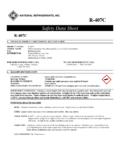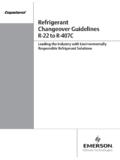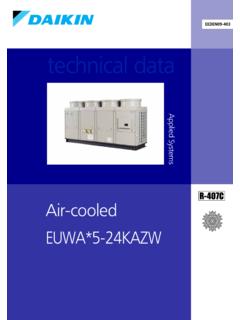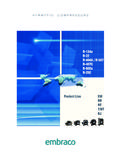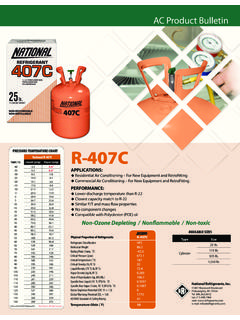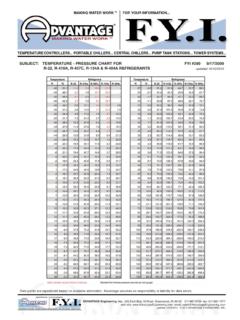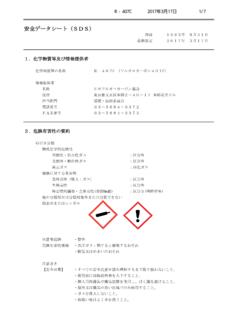Transcription of Guidelines for Utilization of R407C, RD-0005-E
1 2009 Tecumseh Products Company. All rights reserved. Page 1 of 6 DATE: August 2009 REFERENCE DOCUMENT NO. RD-0005-E Guidelines FOR Utilization OF r407c r407c Guidelines FOR Utilization OF 2009 Tecumseh Products Company. All rights reserved. Page 2 of 6 DATE: August 2009 REFERENCE DOCUMENT NO. RD-0005-E Guidelines FOR Utilization OF r407c After many years of testing and investigation, r407c is recognized as a suitable alternative refrigerant for R22 in medium and high temperature applications such as residential and light commercial air conditioning.
2 r407c is a ternary blend of hydro fluorocarbon or HFC compounds, comprising 23% of R32, 25% of R125 and 52% of R134a. It has no chlorine content, no ozone depletion potential, and only a modest direct global warming potential. ODP = 0, GWP = 1610. r407c is NOT a drop-in replacement for R22. In addition to slight capacity losses, there are differences between r407c and R22 that must be considered when handling, processing, applying or retrofitting refrigerants. These Guidelines are offered to assist in understanding the differences. Any Tecumseh compressor with the letter C in the Model Number (Example: AWG5528 CXD) is approved for use with r407c . Pressure F , , , , , , , , , , , , , , REFRIGERANT PROPERTIESA) Pressure/temperature table of r407c vs. R22 is shown in Figure 1. B) Figure 2 (page 2) shows the comparison of some properties of r407c and R22.
3 The data is taken at the standard refrigerant conditions of 5 F (-15 C) evaporating or 86 F (+30 C) condensing. Figure 1 2009 Tecumseh Products Company. All rights reserved. Page 3 of 6 DATE: August 2009 REFERENCE DOCUMENT NO. RD-0005-E Guidelines FOR Utilization OF r407c REFRIGERANT PROPERTIES (Cont d) C) The solubility of water in r407c is comparable to that of water in R22. It is necessary to keep the system dry. See Section II, B. D) Extensive investigation and testing has been conducted to determine that r407c is compatible with all materials used in Tecumseh Products compressors and condensing units. SYNTHETIC LUBRICANTS: POLYOL ESTERS (POEs) and POLYVINYL ETHERS (PVEs) A) Miscibility 1.
4 Miscibility is the ability of the lubricant and the refrigerant to mix. This miscibility is a very important factor in providing proper heat transfer and in returning lubricant to the compressor in a refrigeration system over its range of operating temperatures. 2. r407c and Mineral oils (MO) are not miscible 3. Polyol Ester (POE) as well as Polyvinyl Ether (PVE) oils and r407c are miscible. 4. r407c and Synthetic Alkylate (SA) oils are partially miscible. B) Moisture 1. Polyol ester and polyvinyl ether oils are 100 times more hygroscopic (ability to absorb moisture) than MO or SA oils. This moisture is difficult to remove even with heat and vacuum. 2. Utmost care must be taken to prevent moisture from getting into the refrigeration system. Do not leave the compressor or system open to the atmosphere for longer than 10 minutes maximum.
5 The preferred method of assembly would be to remove system component plugs and caps just prior to brazing. The maximum system moisture content after completing system processing should be 80 PPM. After running the system with the appropriate drier installed, the system moisture level should be 10 PPM or less. These levels are based on measuring moisture in liquid refrigerant samples taken from the system. 3. Always use an appropriate drier in the system when using r407c . (See section on DRIERS.) Figure 2 TemperatureR407CR22R407CR22 Evaporator Condensor Capacity Capacity Capacity PercentEEREEREERP ercent F C F C(Btuh)(Btuh)RatioChange Btu/W-hr Btu/W-hr Ratio ,28212, ,58028, ,93611, ,45516, ,74525, ,51537, ,66945, ,67010, ,28223, ,63042, ,7018, ,54318, ,09128, ,94536, ,74032, of r407c vs R22 2009 Tecumseh Products Company.
6 All rights reserved. Page 4 of 6 DATE: August 2009 REFERENCE DOCUMENT NO. RD-0005-E Guidelines FOR Utilization OF r407c C) Compatibility 1. Extensive investigation and testing have been conducted by Tecumseh Products Company to determine that the polyol ester and polyvinyl ether lubricants approved by Tecumseh are compatible with all materials used in Tecumseh hermetic compressors. Contact your Tecumseh sales representative for the latest list of approved oils. (Policy Bulletin No. 105) 2. While polyol ester and polyvinyl ether oils are compatible with mineral oils, they should not be indiscriminately mixed with mineral oils in r407c refrigerant systems. This practice could result in the inability of the oil to return to the compressor and/or reduce heat transfer performance in the evaporator. However, small amounts up to 5% of mineral oil are acceptable in field retrofit situations (1% or less is preferred).
7 SYSTEM DESIGN A) Compressor Selection Tecumseh is continuing to test and approve r407c compressors with the compatibility of oil, refrigerant, and materials in mind. These compressors will have the letter C as the refrigerant designator, RGA5512 CXA. These compressors are designed to closely match the capacity of their corresponding R22 compressors at their individual rating point. In many cases, the same displacement is used. It will be necessary to test each compressor selection in the applications to determine its suitability, since system operating conditions vary greatly from one application to another. B) Capillary Tube Selection In general, the refrigerating effect of r407c is less than that of R22, thus increasing the required mass flow for a given capacity. However, capillary tubes selected for R22 applications should be adequate for a preliminary selection.
8 As with any capillary tube selection, system testing is necessary to determine the proper final selection. C) Expansion Valve Selection Expansion valve manufacturers have designed product specifically for use with r407c . Consult them for their recommendations. D) Driers Tecumseh requires that an appropriate drier be used on every r407c system. See section on DRIERS. E) Return Gas/Discharge Temperatures The theoretical discharge temperature for r407c is slightly lower than that of R22 at similar conditions. Therefore, existing compressor Guidelines regarding return gas and discharge temperatures for R22 should apply to r407c compressors as well. In general, keeping the return gas cool without flooding liquid refrigerant back to the compressor is beneficial in limiting compressor discharge and motor temperatures to acceptable levels.
9 F) Refrigerant Quantity The refrigerant quantity will depend on the system components. Based on limited application data, the quantity of r407c needed will be about the same as R22. DRIERS A) Synthetic lubricants used with r407c are prone to hydrolyze with moisture resulting in the formation of acids. Tecumseh requires that an appropriate drier be used in every r407c application. B) The types of driers which should be used are the molecular sieve types that are compatible with R22. The XH-6 (bonded core), XH-7 and XH-9 types are recommended. The XH-6 (loose fill) type is not recommended due to its somewhat higher attrition rate. C) For specific drier selection, contact your drier supplier. SYSTEM PROCESSING A) Compatibility 1. Polyol ester and polyvinyl ether oils are good solvents and have a tendency to wash system processing materials such as drawing components, rust inhibitors, and cleaning compounds from system surfaces.
10 Care must be taken to remove such processing materials from all the system components. 2. Residual chlorinated materials should be considered system contamination and eliminated from all internal surfaces of the refrigeration system. 2009 Tecumseh Products Company. All rights reserved. Page 5 of 6 DATE: August 2009 REFERENCE DOCUMENT NO. RD-0005-E Guidelines FOR Utilization OF r407c B) Evacuation 2. The evacuation levels for r407c systems should be the same as R22 systems (minimum of 200 microns at the system and pulled from both the low and high pressure sides of the system). If care is not taken to prevent moisture from entering the system components prior to assembly, evacuation could be expected to take longer to achieve acceptable limits of system moisture from entering the system components prior to assembly, evacuation could be expected to take longer to achieve acceptable limits of system moisture and non-condensable.
